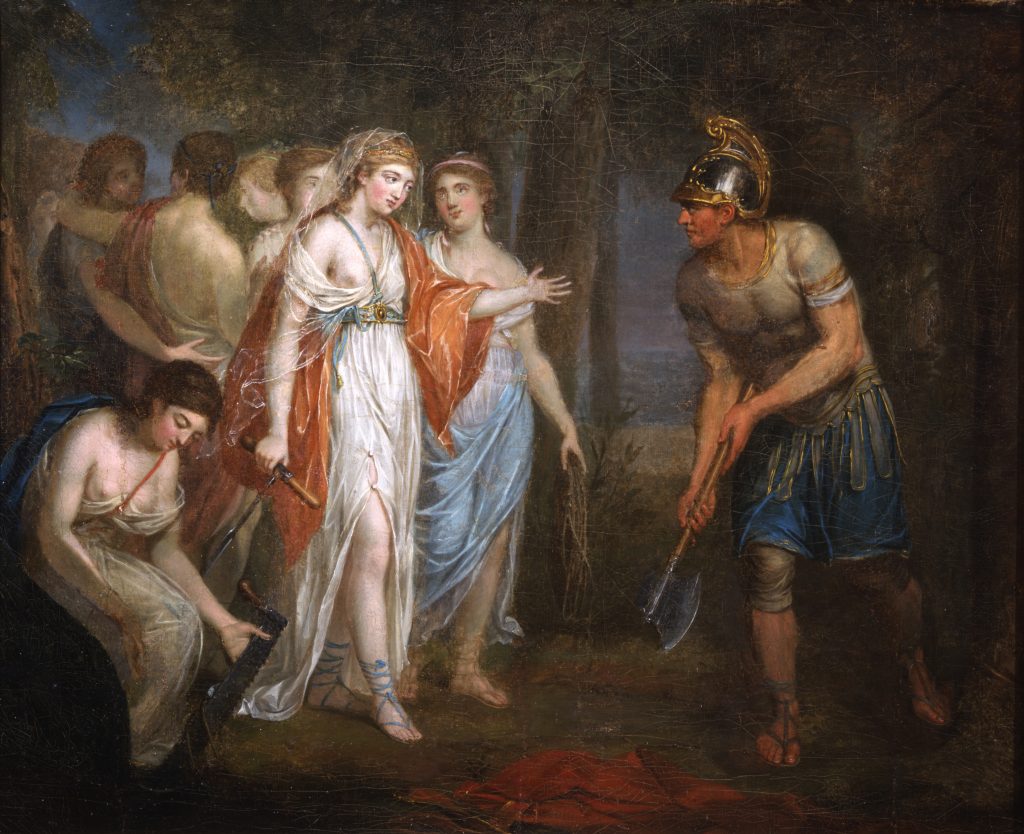
Classical myths and legends were popular subjects of allegorical paintings in the eighteenth century, like this one of Cincinnatus attributed to Angelica Kauffmann (1740-1807).
At its inception in 1783, the Society of the Cincinnati took its name from the Roman general Lucius Quinctius Cincinnatus. That the Society would look to ancient Rome for inspiration was hardly unusual. The culture of the classical world served as a foundation for American ideals and mores in the eighteenth century. The images of Cincinnatus in the Institute’s collections demonstrate how prevalent the principles represented by the Society’s namesake were in eighteenth-century American life. These collections illustrate the significance of Cincinnatus not only as the Society’s lodestar but also as what he represents in the context of early American history—an affirmation of a new nation’s values by linking them with the long-respected principles of ancient Rome.
Who was Cincinnatus? A well-respected soldier and landowner from the patrician class, he served as consul in 460 BCE and as dictator in 458 and 439. Consuls were the chief military and civil magistrates in the Roman republic; two were elected annually to serve a year-long term. Dictators, on the other hand, were given absolute magistracy during military or domestic crises. Dictators were appointed to accomplish a particular task, usually to lead an army into battle, and were expected to resign once the task was completed.
During the reign of Caesar Augustus (63 BCE-14CE), the historians Livy and Dionysius of Halicarnassus used Cincinnatus in their works as an early model of civic virtue. In 458 BCE, Roman troops led by the consul L. Minucius Esquilinus were under siege by the Aequi tribe on Mount Algidus. According to Livy’s Ab Urbe Condita, Cincinnatus was called from his modest farm and appointed dictator, charged with the task of breaking the siege on Esquilinus. Within a fortnight Cincinnatus had assembled an army, defeated the Aequi and surrendered his office, returning to his farm. Livy contrasted Cincinnatus with the cautionary tale of Appius Claudius, whose reign Livy saw as a historical example of excess and abuse of power.
In Roman Antiquities, Dionysius of Halicarnassus also used Cincinnatus as a model of Roman virtue: “The only reason, that induced me to relate all these particulars, was to let all the world see what kind of men the Roman magistrates were at that time; that they worked with their own hands, and were temperate; that they were not uneasy under innocent poverty; and were so far from aiming at regal power, that they refused it even when offered.” Dionysius next compared Cincinnatus to “the Romans of this age,” lamenting that they pursued “everything that is contrary to their maxims.”
Cincinnatus also represented the virtuous agrarian life. The philosopher and statesman Cicero chronicled the second dictatorship of Cincinnatus in Cato Maior de Senectute, written in 44 BCE. Late in life Cincinnatus was once again appointed dictator, this time to resolve the affair of Spurius Maelius, a wealthy plebian accused of inciting revolt. In his narrative, Cicero explicitly used the image of Cincinnatus at his plow to glorify the “rustic” virtues of the citizen-soldier: “In my opinion, indeed, I know not whether anyone can be more happy: and not only in the discharge of duty, because to the whole race of mankind the cultivation of land is beneficial; but also … that fullness and abundance of all things which are connected with the food of men.” The strong imagery used by Livy, Dionysius and Cicero lent a mythical aura to their depictions of Cincinnatus; even as early as the Augustan Age, Cincinnatus appears larger than life.
Images of Cincinnatus appeared in early modern Europe and, by the eighteenth century, in America. They employed easily identifiable traits, drawing from Livy, Cicero and Dionysus of Halicarnassus. Cincinnatus—by then a well-known model of public servitude—is often shown at the moment he is approached on his farm by members of the Senate. In these scenes, he is usually at his plow wearing the working clothes of a farmer—in contrast to the purple-trimmed toga presented to him as a symbol of his office. In other works, Cincinnatus is shown returning from his term of service, as seen in The Return of Cincinnatus, a late eighteenth-century allegorical painting in the Institute’s collections. In this work, women greet Cincinnatus bearing agricultural tools while a sagum, the red cloak worn by Roman soldiers, lies discarded on the ground, symbolizing the rejection of military power by Cincinnatus. Cincinnatus is also commonly depicted putting on his sandals, although this portrayal was attributed interchangeably to Cincinnatus, Jason or Hermes. Few images of Cincinnatus show him in any settings other than the offer of dictatorship or the return home, emphasizing that his significance lies not in military victory but in humility and duty.
That Americans were deeply familiar with the story of Cincinnatus shows how classical history and philosophy permeated eighteenth-century American culture. Admittance to early American institutions of higher learning was largely based on an applicant’s knowledge of the classics; grammar schools tailored their curricula to meet this requirement. The educated elite were quite familiar with Livy and Cicero in the original Latin, while retellings in English were accessible to even rural communities—communities that were becoming increasingly literate. For example, Cincinnatus was included as a model of “disinterestedness” in L. M. Stretch’s Beauties of History, a late eighteenth-century publication “for the instruction and entertainment of youth.” The Boston bookseller Henry Knox, who later served as chief of artillery during the Revolutionary War, stocked Oliver Goldsmith’s Roman History in which Cincinnatus appears. Here Goldsmith’s “only aim was to supply a concise, plain, and unaffected narrative of the rise and decline of a well-known empire.” These examples demonstrate that classical ideals appealed not only to the intellectual leaders of the day but also to those living in more remote reaches of the colonies.
During a period in American history in which many educated individuals lived in rural settings, it is no wonder Cincinnatus captured the American imagination. Revolutionary leaders saw the agrarian ideals of hard work, frugality, duty and autonomy as a moral and philosophical framework for their vision of the new republic; they drew parallels between Roman virtues of public servitude and agrarianism and Americans’ own sacrifice for their country. As a farmer and commander-in-chief of the Continental Army, George Washington was uniquely equipped to serve as a contemporary embodiment of these ideals.
Washington’s image—that of a citizen-soldier who selflessly served his country before returning to his farm—so clearly recalled the values of Cincinnatus that he was often referred to as the “American Cincinnatus” or the “Cincinnatus of the West,” even before the founding of the Society of the Cincinnati. His resignation of his commission in 1783 drew parallels to the portraits of Cincinnatus by Livy and Cicero. John Trumbull and Charles Willson Peale, among others, expressed these parallels in artistic works, like Jean-Antoine Houdon’s full-length statue of Washington as Cincinnatus. In Houdon’s statue, Washington leans against a fasces, a symbol of the Roman dictatorship, and at his back is a plow, another nod to Cincinnatus.
The resignation of Washington and the founding of the Society of the Cincinnati demonstrate how the virtues exemplified by Cincinnatus remained relevant after the war. Washington, the American Cincinnatus, served as the first president general of the Society. This fraternal organization of Continental Army and Navy officers and their French counterparts impressed upon the members in its founding document, the Institution, to follow the example of Cincinnatus “by returning to their citizenship.” In following the immutable principles set forth in the Institution, the Society’s founding members emulated Cincinnatus’s sense of duty and his role as the citizen-soldier.
Maj. Pierre-Charles L’Enfant was responsible for designing the emblems of the Society which prominently feature images of Cincinnatus. His design for a circular medal depicts the call to the dictatorship and Cincinnatus’s return home. Although the medal was not struck in the early days of the Society, L’Enfant incorporated the design into both the diploma and the Eagle insignia of the Society. L’Enfant considered an insignia, rather than a medal, to be more fitting—in the tradition of European orders with which he was familiar. Both sides of the Society’s insignia, known as the Eagle, feature images of Cincinnatus—leaving the farm on the obverse and his triumphant return on the reverse—and the obverse includes the Society’s motto, Omnia relinquit servare rempublicam (He gave up everything to serve the republic). L’Enfant’s original designs for these emblems are preserved in the Society archives.
These images of Cincinnatus, a model of civic service and agrarian virtue for ancient Rome, reveal how he served a similar role in eighteenth-century America, as intellectual leaders looked to the past to shape their vision for the new republic. While Washington was hailed as the American Cincinnatus, he was not the only one who endeavored to emulate that citizen-soldier of antiquity. Indeed, the plural usage in the Society’s name affirms that each member would strive for the ideals of service, hard work and humility—a whole generation of Cincinnati setting an example for the new American republic.
Images of Cincinnatus from the age of revolution are found in some of the world’s great collections. Among the finest is Cincinnatus Abandons the Plough to dictate Laws to Rome (ca. 1806) by Juan Antonio Ribera y Fernández, now in the Museo del Prado in Madrid.
View More from the Society Archives
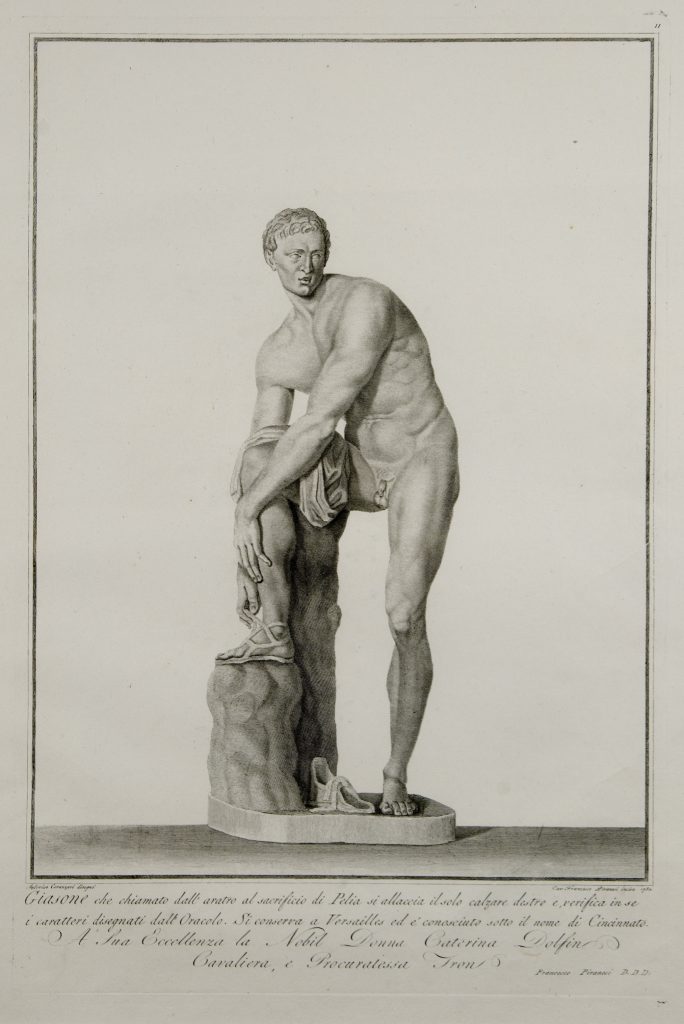
Giasone che chiamato dalli aratro al sacrificio di Pelia
Francesco Piranesi, engraver, after Ludovico Corazzari, artist
1785The Robert Charles Lawrence Fergusson Collection
This engraving depicts a statue on the grounds of Versailles. The title indicates that the statue is “known under the name of Cincinnatus.”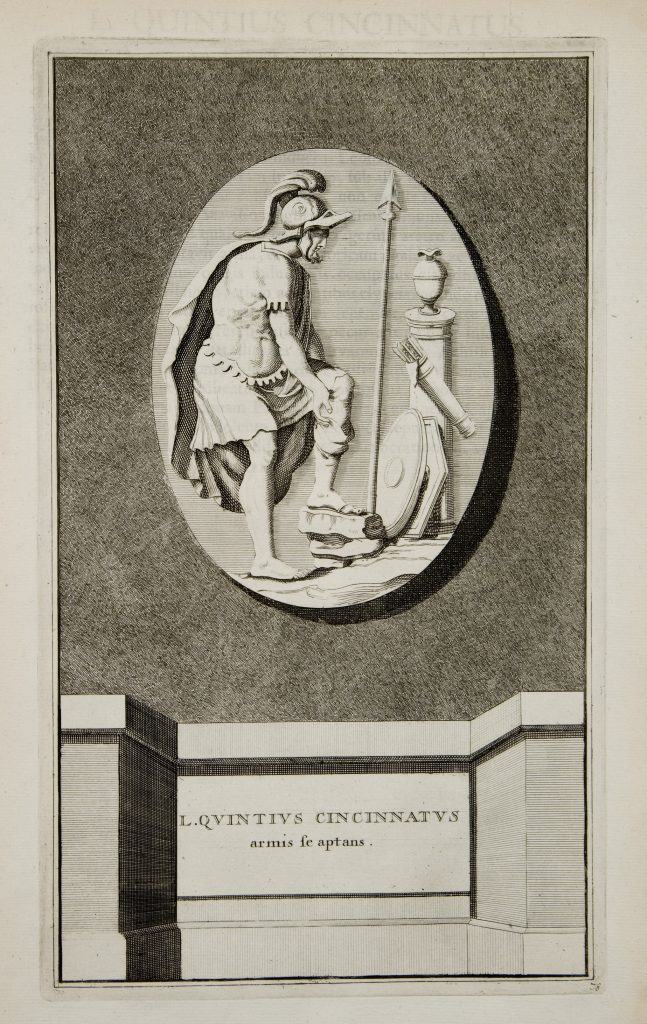
L. Quintius Cincinnatus, armis fe aptans
ca. 1690The Society of the Cincinnati, Library purchase, 2008
Cincinnatus was often depicted in the simple act of securing his sandals, symbolizing his humility and duty. This plate is likely from Thesaurus Graecarum Antiquitatum, a seventeenth-century work on ancient Greece and Rome.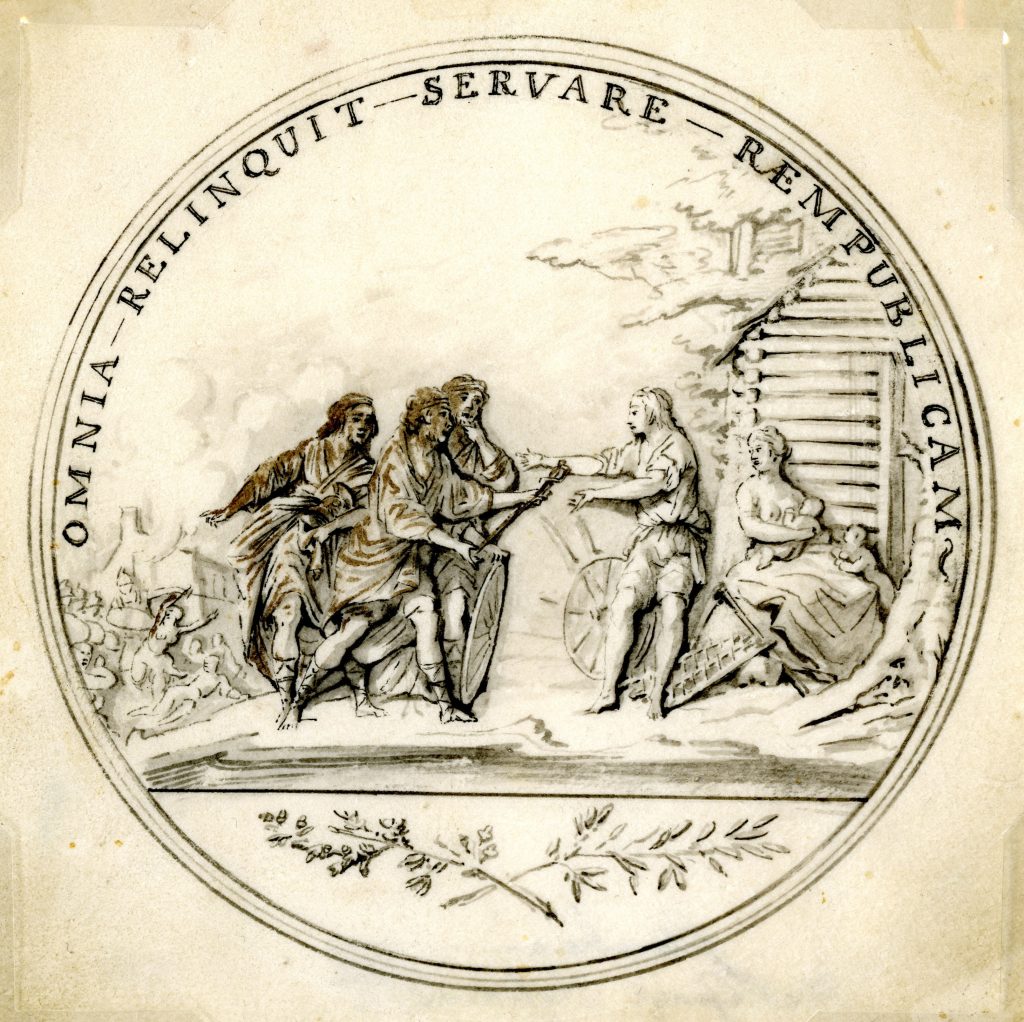
Sketch for the Society of the Cincinnati medal, obverse
Pierre-Charles L’Enfant
June 1783The Society of the Cincinnati Archives
This pen-and-ink drawing of the obverse of a proposed Society medal depicts Cincinnatus receiving his sword from Roman officials who are calling on him to defend their country in war.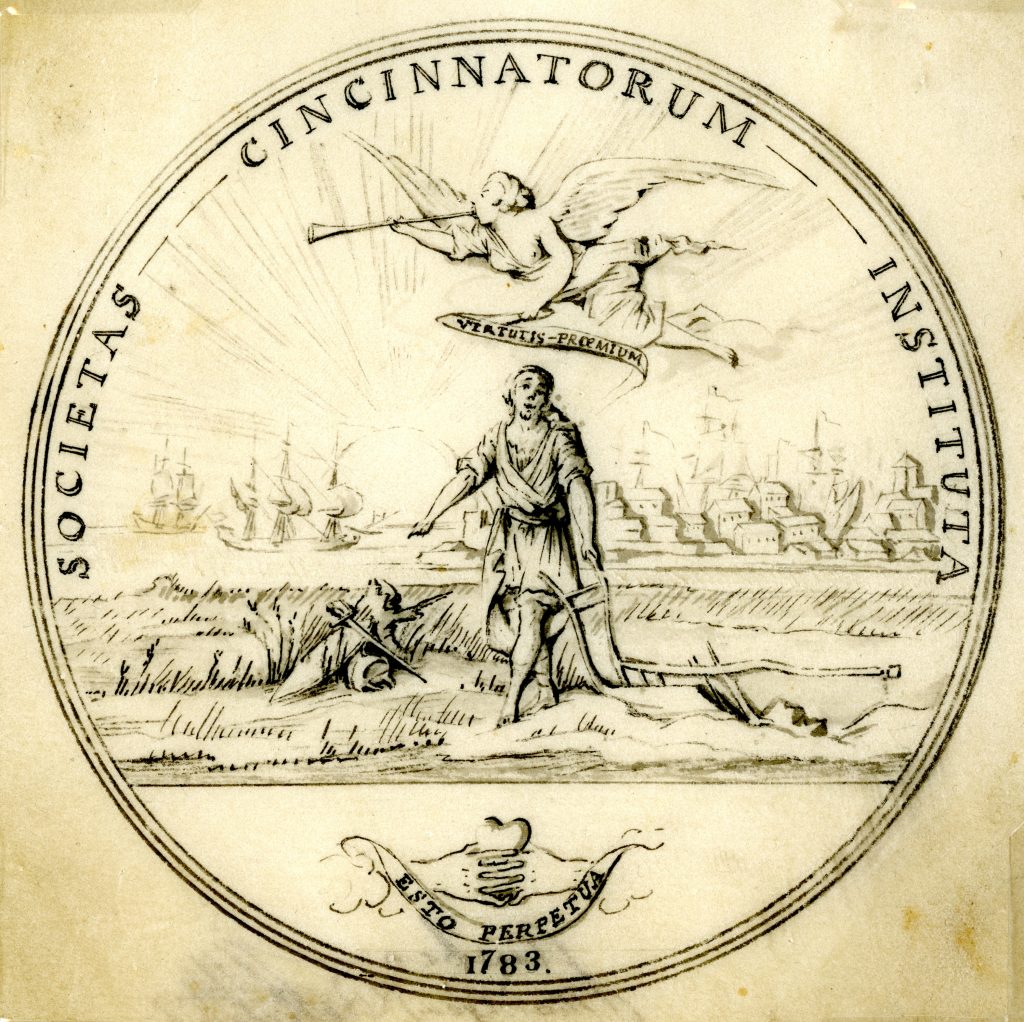
Sketch for the Society of the Cincinnati medal, reverse
Pierre-Charles L’Enfant
June 1783The Society of the Cincinnati Archives
The reverse side of the medal shown in L’Enfant’s pen-and-ink drawing features the victorious Cincinnatus returned to his plow, with the figure of Fame flying over him holding a banner that reads “Virtutis Praemium.”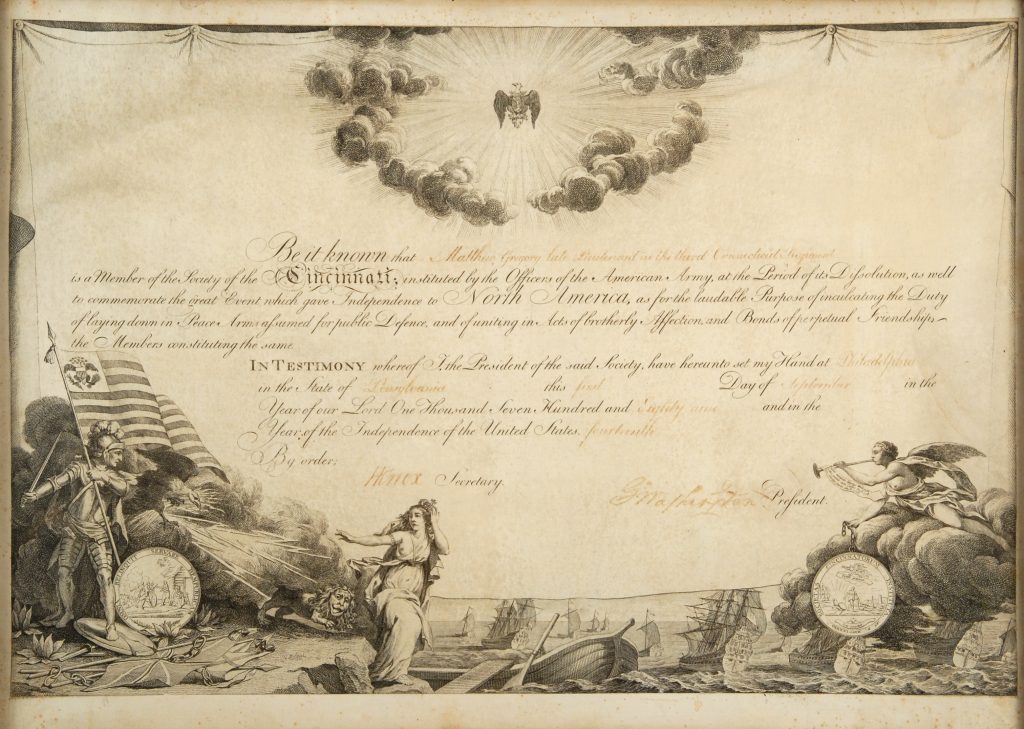
Society of the Cincinnati diploma
September 1, 1789Gift of Mrs. Edward Correa, 1955
The imagery on this diploma is based on Pierre L’Enfant’s original sketch for the Society’s membership certificate. The medal featuring the story of Cincinnatus is in the lower left and right corners. This diploma belonged to Lt. Matthew Gregory, who served in the Third Connecticut Regiment, and is signed by Henry Knox and George Washington.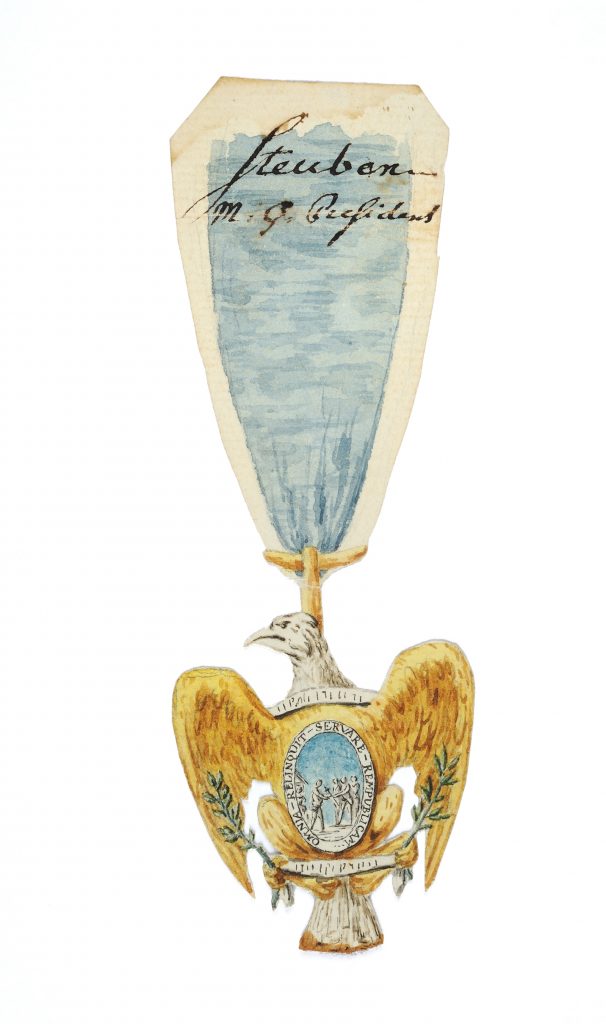
Sketch for the Society of the Cincinnati Eagle
Pierre-Charles L’Enfant
June 1783The Society of the Cincinnati Archives
L’Enfant’s original sketch for the Society’s insignia, cut out to convey its actual proportions, is endorsed by Maj. Gen. Friedrich Wilhelm von Steuben, a founding member of the Society who served as acting president general briefly before George Washington took office. It bears on each side a medallion depicting scenes of the life of Cincinnatus.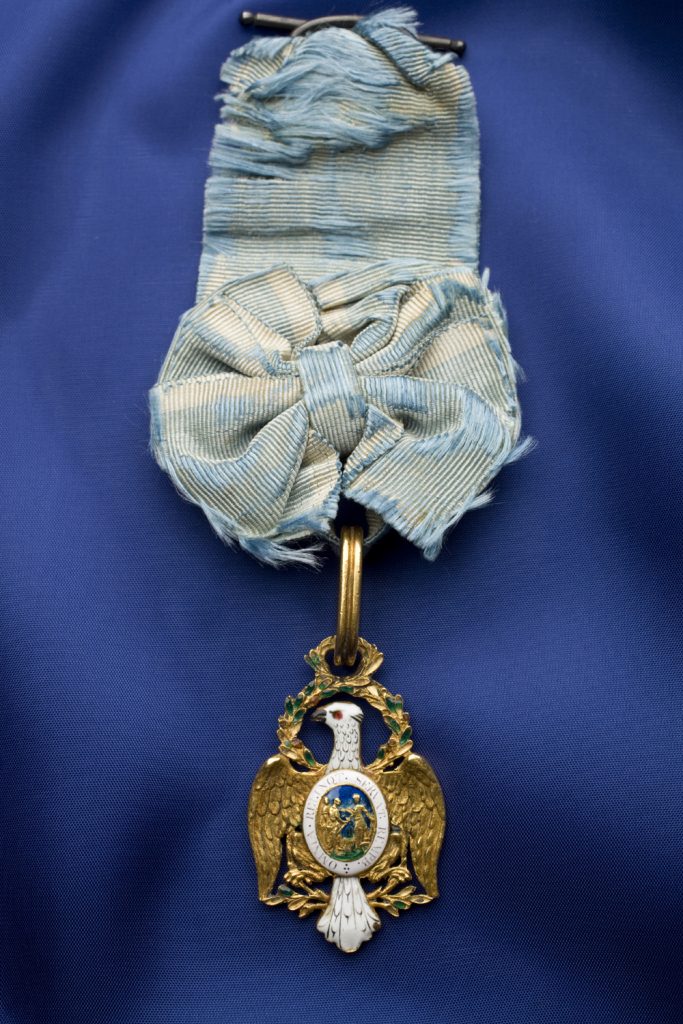
Society of the Cincinnati Eagle insignia
Nicolas-Jean Francastel and Claude-Jean-Autran Duval, Paris
1784Gift of Harrison Tilghman, Society of the Cincinnati of Maryland, 1953
The gold-and-enamel Society Eagle bears an oval medallion on each side depicting scenes of Cincinnatus. This insignia was presented by George Washington to one of his aides-de-camp, Lt. Col. Tench Tilghman of Maryland, and is suspended from the original blue-and-white silk ribbon.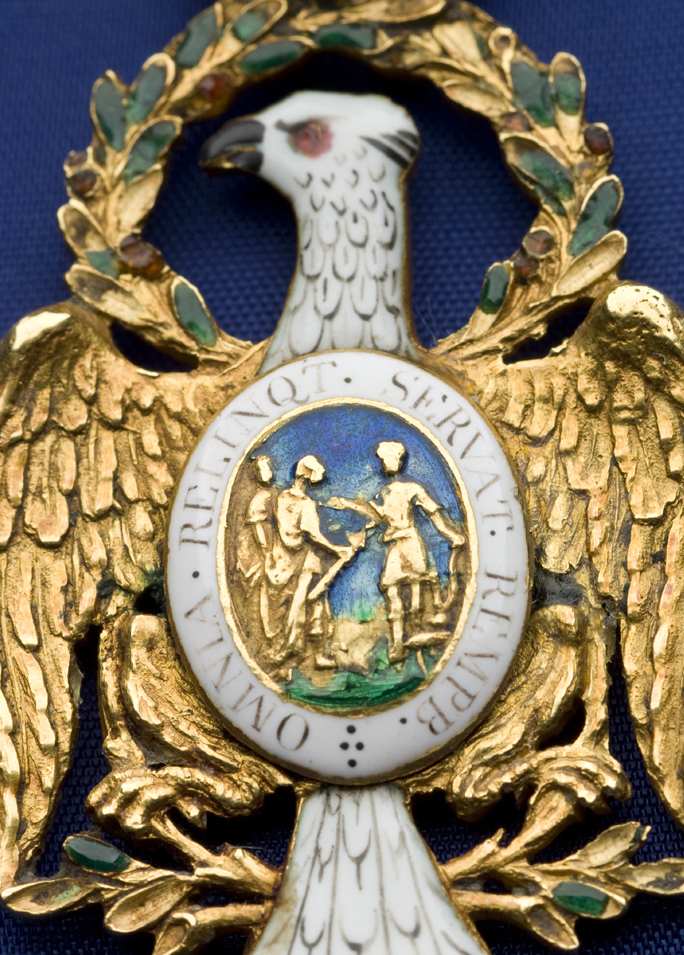
Detail of the Society of the Cincinnati Eagle insignia, obverse
Nicolas-Jean Francastel and Claude-Jean-Autran Duval, Paris
1784Gift of Harrison Tilghman, Society of the Cincinnati of Maryland, 1953
The oval medallion on the obverse of the Eagle depicts Cincinnatus receiving a sword from two representatives of the Roman senate.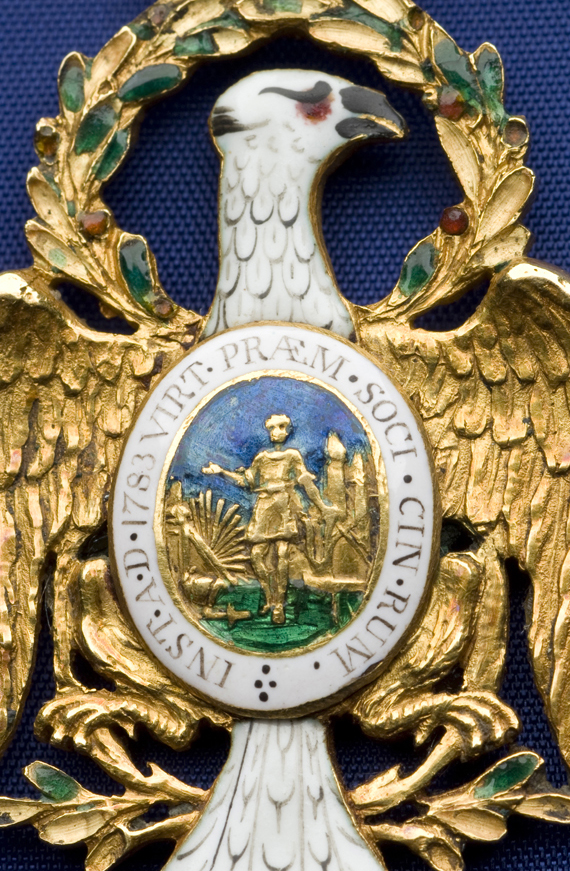
Detail of the Society of the Cincinnati Eagle insignia, reverse
Nicolas-Jean Francastel and Claude-Jean-Autran Duval, Paris
1784Gift of Harrison Tilghman, Society of the Cincinnati of Maryland, 1953
The oval medallion on the reverse of the Eagle shows Cincinnatus having returned triumphantly to the plow.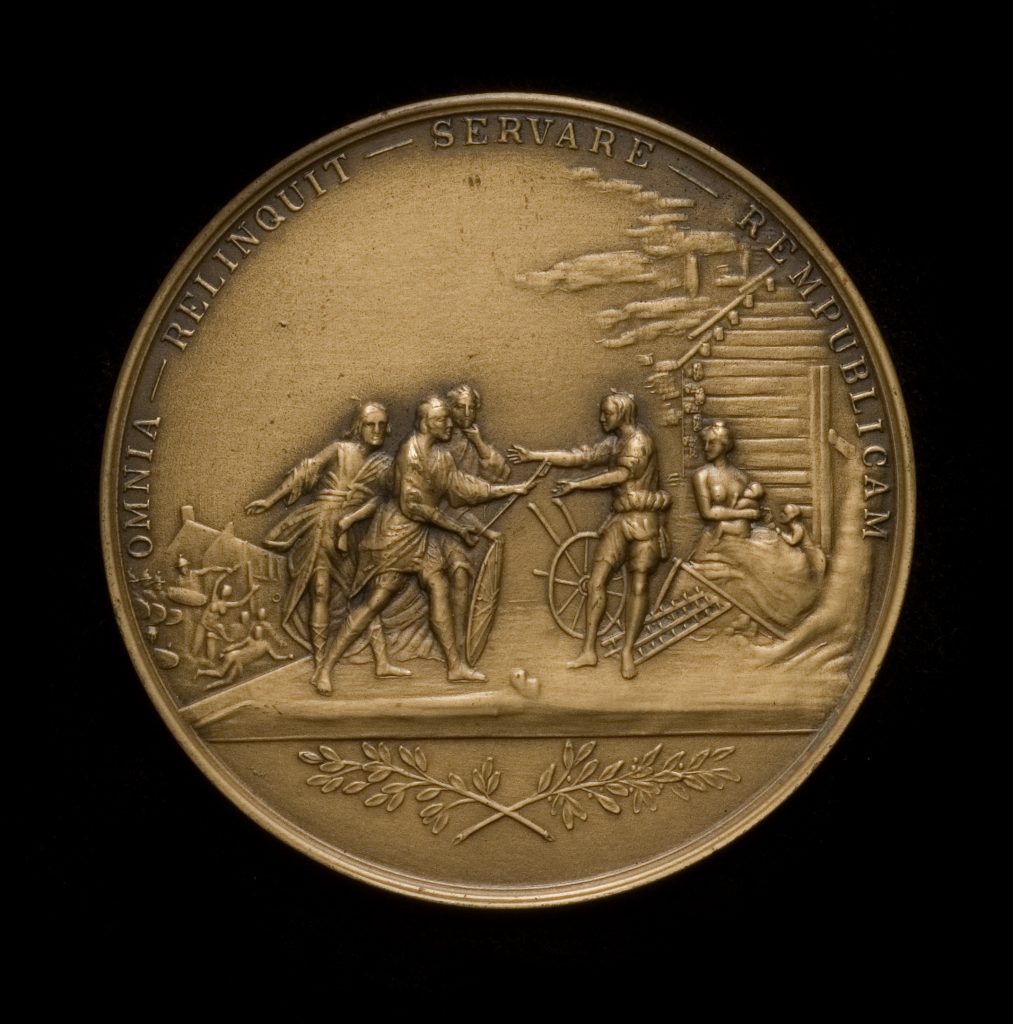
Medal commemorating the Society of the Cincinnati Triennial Meeting of 1914, obverse
Whitehead and Hoag Company, Newark, N.J.
1914Gift of Paul Thruston Mackie, Society of the Cincinnati in the State of Virginia, 1959
L’Enfant’s design for a circular medal bearing the Society’s emblems was not struck for the first time until the early twentieth century. This bronze example was made to commemorate the Society’s Triennial Meeting in Baltimore in 1914.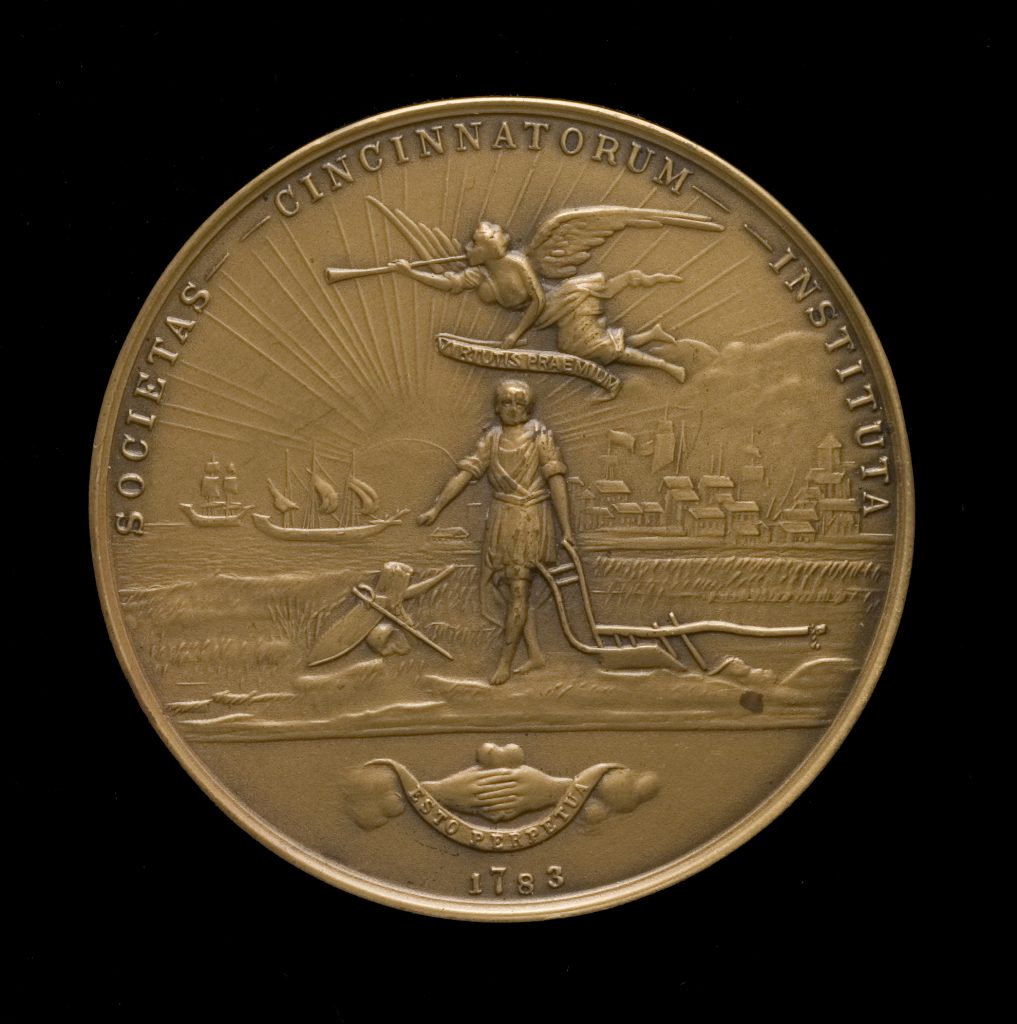
Medal commemorating the Society of the Cincinnati Triennial Meeting of 1914, reverse
Whitehead and Hoag Company, Newark, N.J.
1914Gift of Paul Thruston Mackie, Society of the Cincinnati in the State of Virginia, 1959
This bronze circular medal is an extremely faithful rendering of L’Enfant’s 1783 design, including the detailed cityscape and ships in the background.